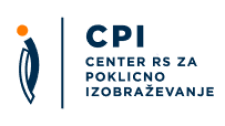Magister grafični inženir/magistrica grafična inženirka
Selected qualifications
| Name of qualification | Name of qualification: Magister grafični inženir/magistrica grafična inženirkaAdd to comparison |
|---|---|
| Translated title (no legal status) | Translated title: Master of Arts in graphic engineering |
| Type of qualification | Type of qualification: Master’s degree |
| Category of qualification | Category of qualification: Educational Qualification |
| Type of education | Type of education: Master's education |
| Duration |
Duration of education:
2 years
|
| Credits | Credits: 120 credits |
| Admission requirements |
Entry conditions:
|
| ISCED field |
Field:
Arts and humanities
|
| ISCED subfield | subfield: audio-visual techniques and media production |
| Qualification level |
SQF Level:
SQF 8 |
Learning outcomes:
The qualification holder will be able to:
(general competences)
- demonstrate advanced technical knowledge acquired through the study of theoretical and methodological concepts, linked to training in searching for new sources of knowledge using scientific research methods,
- perform critical reflection,
- experiment and visually communicate various intellectual concepts,
- learn independently in own professional and academic field,
- demonstrate understanding of the interdependence of technology and design,
- demonstrate understanding of artistic language and its technological translation into graphic products,
- show initiative and autonomy in decision-making and in managing the most complex working systems,
- demonstrate social and communication skills in leading teamwork, including in the field of projects based on integration of scientific laws from various fields,
- demonstrate professional, ethical and environmental responsibility,
- use modern tools and skills, above all from the ICT field, in everyday professional work and research.
(subject-specific competences)
- demonstrate advanced knowledge of mathematics, technical mechanics, organic and physical chemistry and scientific thought,
- evaluate the technological characteristics and strengths and weaknesses of advanced web technologies and new media,
- observe with sensitivity and depth and perceive and understand the hidden (invisible) and visible constitutional, compositional, aesthetic and communicative characteristics of a graphic product,
- develop autonomy, research skills and critical and self-critical evaluation of the use of typography for different products and contents and different information media,
- create own font on the basis of theoretical foundations for the entire range of letter and non-letter symbols; verifying its suitability for use using appropriate methods in project work,
- demonstrate familiarity with photography as a modern applied, visual, communicative medium in the design of graphic products with an emphasis on a faultless technical, aesthetic, expressive and compositional organisation of the results achieved,
- demonstrate interactions between the surface of printed materials, coatings, printer inks, adhesives, lacquers,
- demonstrate familiarity with the theory of mixing and reproducing colours in the graphic reproduction process through the study of different mathematical models describing the workings of the system, its weaknesses and strengths and possibilities for improvements; resolve complex mathematical models and focus on critical reflection and finding solutions to the problems of colour reproduction in printed media,
- demonstrate knowledge and understanding of the foundations and development of rasterisation theory in printed media,
- develop knowledge of the theoretical basics of multicolour reproduction in conventional and digital printing techniques and in analogue and digital colour photography and electronic (interactive) media; demonstrate knowledge of the theory of additive, subtractive and optical colour mixing, colour appearance models, and the effect of metamerism, shine, contrast and other factors on colour reproduction or colour perception,
- demonstrate knowledge of and creatively incorporate language technologies into modern products and services, including mobile applications,
- use natural interactivity in designing modern user interfaces,
- demonstrate in-depth understanding of modern applications of the interdisciplinary field of interactive systems in the field of investigation and extraction of information.
Assesment and completion:
Examination performance is graded as follows: 10 (excellent); 9 (very good: above-average knowledge but with some mistakes); 8 (very good: solid results); 7 (good); 6 (adequate: knowledge satisfies minimum criteria); 5–1 (inadequate). In order to pass an examination, a candidate must achieve a grade between adequate (6) and excellent (10).
Progress:
In order to progress to the second year, students must have completed at least 54 credits.
Progression:
Third-cycle doctoral study programmes (SQF level 10)
Conditions for obtaining a public document:
To complete their studies, students must complete all course units in all subjects in which they have enrolled and prepare and defend a master's thesis.
Awarding body:
University of Ljubljana, Faculty of Natural Sciences and Engineering
URL
Awarding body URL:Upcoming event
26. 08. 2020
International Conference: 10 years of Slovenian Qualifications Framework
International Conference: 10 years of Slovenian Qualifications Framework Brdo Congress Centre, Predoslje 39, 4000...
© Center RS za poklicno izobraževanje, 2018. All rights reserved
Sitemap General legal notice Cookie Policy Production: ENKI






